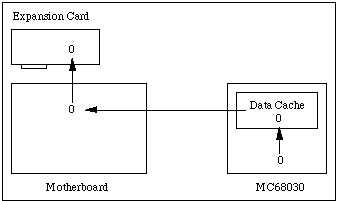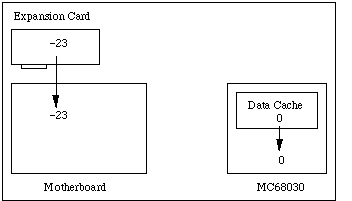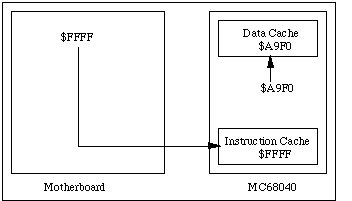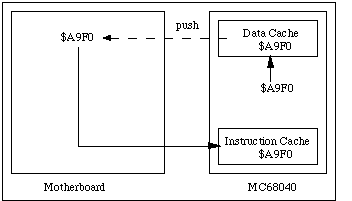|
|
This Technical Note documents cache behavior, manipulation
of processor caches, and manipulation of external caches on
Macintosh models that incorporate these features. It also
describes how system software uses a memory management unit
(when available) to implement special caching options.
[Oct 01 1991]
|
Cache Machines
The Motorola MC68020 microprocessor includes a 256-byte
internal instruction cache. The MC68030 includes a
similar-size instruction cache plus a 256-byte writethrough
data cache. The MC68040 has much larger caches, 4K of
instructions, and 4K of data. It also supports copyback
caching in addition to the writethrough caching used by the
MC68030.
The difference between writethrough and copyback caching
is a matter of whether data writes go directly and
immediately to main memory, or whether they go only as far
as the data cache to be copied back to main memory later (if
necessary) in a highly optimized fashion.
The MC68030 and MC68040 include memory management units
internally. Besides the ability to divide memory into
logical pages and provide memory access control, these
memory management units can also associate cacheability
attributes with individual pages of memory, affecting how
data is cached on a page-by-page basis.
Back to top
Stale Data (Baked Fresh Daily)
Caching greatly improves overall system performance but
introduces the problem of stale data, or inconsistency
between cached data and the data in actual memory (RAM). In
certain cases, cache maintenance instructions are necessary
to maintain coherency between cache and main memory.
Stale Instructions
The first time when stale data becomes a problem occurs
when writing self-modifying code on the MC68020 or any other
processor with an instruction cache. The instruction cache
remembers, separately from main memory, many of the
instructions it has recently executed. If the processor
executes an instruction, later changes that instruction in
memory, and then tries to execute the new instruction at the
same address, there is a probability that the original
instruction is still cached. Since the cache is used before
main memory, the old instruction may be executed instead of
the new one, resulting in incorrect program operation.
To prevent this, any time a program changes an executable
instruction in memory, it must flush the instruction cache
before attempting to execute the modified instruction.
Flushing a cache invalidates its entries, forcing the
processor to refill cache entries from main memory. In part,
this defeats the purpose of a cache and hurts performance.
Nevertheless, the alternative is incorrect program
operation. This serves to emphasize that caches must always
be flushed judiciously in order to maintain correct
operation and optimal performance.
As described, self-modifying code is not just code that
changes itself directly as it executes. It can be much more
subtle. Code that modifies a jump table entry is modifying
executable code and must flush the instruction cache. Patch
installation code often copies code from one block of memory
into another and may modify one or more JMP
instruction operands in order to get back to the original
routine--either technique requires flushing the instruction
cache.
Stale Data
With the addition of the data cache in the MC68030,
performance is further enhanced, but another cache offers
another source of stale data.
Let's say that you have a whizzy disk controller card
that supports DMA. The board reads command buffers from the
main CPU's memory area and writes status information back to
the command buffer when done. Before the command is started,
the MC68030 sets up the command buffer and zeroes the status
code (the following figures are not to scale).

Figure 1. Write (Writethrough Cache)
At this point the cache and the memory both contain the
value 0, since the MC68030's cache is writethrough (that is,
it always writes data to memory immediately). Now the
MC68030 starts the command running and waits for an
interrupt from the disk controller card. It then reads back
the status from the command buffer, which is modified by the
DMA card.

Figure 2. Read (From Cache)
Oops! Because the status code's value is already cached,
the MC68030 thinks that the status is 0, even though the
actual value in memory is -23. This type of thing can cause
some very hard-to-find bugs in your driver.
Copyback Data and Stale Instructions
There is another type of cache called a copyback cache
that is supported by more advanced microprocessors like the
MC68040. A copyback cache further improves system
performance by writing data to external memory only when
necessary to make room in the cache for more recent
accesses, or when explicitly "pushed" by system software.
This is extremely valuable for relatively small, short-lived
data that are accessed frequently but don't need to persist
for a long time, like local stack frames in C and Pascal
function calls.
This increase in performance again comes at some cost in
terms of maintaining cache coherency. Here, the problem is
twofold. Fundamentally, a datum that is "written to memory"
isn't really in memory (meaning main RAM) until it's pushed
out of the data cache. When performing DMA, it is necessary
to push data cache contents into memory before instructing
alternate bus masters to look for it; they'll only find
stale data if it's still cached. Second, and perhaps even
more important, the instruction and data caches are
completely independent of each other. When fetching
instructions, the processor looks in only two places: first
the instruction cache, then main memory. It does not look in
the data cache. When performing the types of operations
described above that can cause a stale instruction cache,
one must remember that it is impossible to make the
instruction cache and memory coherent if memory itself is
stale! The data cache must be flushed; then and only then
can the instruction cache refill with the valid data the
processor has written.
Here, some code writes the _LoadSeg trap to memory as
part of a jump table update. Figure 3 indicates what happens
if only the instruction cache is flushed. When execution
later proceeds through that jump table entry, the processor
fetches the opcode from that address and gets zonked with an
illegal F-line exception. Why? _LoadSeg is still in the data
cache. The code responsible for maintaining the jump table
failed to push the contents of the data cache before
invalidating the instruction cache. This certainly causes
problems on the MC68040.

Figure 3. Write (Copyback Cache) and Fetch
Another similar problem applies to the time at which
cache flushing is performed. When using a writethrough data
cache, it is acceptable to invalidate the instruction cache
first and then modify instructions in memory. With a
copyback data cache, it is imperative to make changes to
memory first and then flush caches. Again, this ensures that
copyback data is written to memory before the instruction
cache attempts to refill from memory. The key point to
remember is that the MC68040 instruction cache always reads
from memory, never from the data cache.
Figure 4 shows the path that an instruction properly
takes when it is first written as data by a program that
modifies instructions in memory.

Figure 4. Write
(Copyback Cache), Push, and Fetch
It's worth noting here that although pushing copyback
data to memory and invalidating (flushing) the cache are
conceptually different operations, they are at least for the
MC68040 irrevocably connected. This makes flushing the data
cache for the sake of pushing its contents to memory a
potentially expensive one. Valid cache data is essentially
lost when it is pushed and must be read from main memory if
it is to be accessed again. This should be another
reinforcement that cache flushing must be performed
judiciously. It is possible to flush only a portion of the
MC68040 caches, and software that flushes caches frequently
should consider this optimization to avoid unnecessary
performance degradation when running on this processor. See
the interfaces provided below.
What Is Apple's Part in This?
There are two answers to this question. First, there are
things that Apple has done in ROM to make life easier while
dealing with a caching processor. Second, there are
functions provided in ROM or in system software to allow
developers to take some control of their own destinies.
Things That Happen for You
Ever since the Macintosh II made its debut, it has been
flushing the instruction cache. It does so at a number of
critical points where code may be moved to a new location,
potentially leaving memory and the instruction cache
incoherent. Specifically, there are a number of traps that
have the potential to move code around memory. In each of
these cases, the instruction cache is flushed by system
software or ROM.
_BlockMove _LoadSeg
_Read _UnloadSeg
Warning: The _BlockMove trap is not
guaranteed to flush caches for block sizes 12 bytes or less.
This is a performance optimization. _BlockMove is
called often by system software to move small blocks of
memory that are not executable instructions. Flushing the
cache in all such cases causes significant performance
degradation. When moving very small blocks of code with
_BlockMove, use one of the explicit cache flushing routines
described below.
|
Note:
C programmers should not
assume that the standard library function memcpy() invokes
_BlockMove. An explicit cache flush is required after moving
code with memcpy().
|
In general, there may be others. As a rule of thumb, the
instruction cache needs to be flushed explicitly only as a
result of actions taken by user code, not as the result of
anything a trap might have done. Traps can take care of
themselves.
A memory management unit allows individual pages of
memory to be marked noncachable. In current Macintosh
implementations, NuBus(TM) and I/O address spaces are always
marked noncachable--the processor won't cache memory stored
at NuBus or I/O addresses. This solves any problems of stale
data when processor/DMA "mailboxes" are located in NuBus
memory and eliminates the fundamental problem of stale data
at memory-mapped I/O locations. Data at RAM and ROM
addresses are cachable, which makes sense and maximizes
performance.
Since DMA still poses a problem when common buffers are
located in main RAM, it would seem that there should be
greater intrinsic support for specifying cachability. There
is. In order for DMA masters to be compatible with abstract
memory architectures like those defined by the Macintosh
IIci and even more so by virtual memory, they must use the
GetPhysical routine. Before using GetPhysical, a range must
always be locked with LockMemory. Since this sequence is so
commonly required when performing DMA, the LockMemory
routine has the effect of either disabling the data cache or
marking the corresponding pages noncachable, depending on
what's possible and what makes the most sense. In many
cases, therefore, it is unnecessary to explicitly flush the
data cache. If common DMA buffers are locked with
LockMemory, the operating system ensures cache coherency at
least for those buffers.
To ensure compatibility with existing code while taking
advantage of copyback cache mode, the FlushInstructionCache
function on an MC68040 actually flushes both caches using
the CPUSHA BC instruction. This prevents the need for
modification of correct existing code which properly flushes
the instruction cache with FlushInstructionCache. If code is
written properly for the MC68020 and MC68030, it will work
on the MC68040 as well, without modification. If code is
written incorrectly or directly manipulates the CACR
register of these processors it will fail on the MC68040.
When modifying code in memory or moving code about memory,
use FlushInstructionCache before executing that code.
Facilities That Are Provided for You
Apple provides some system calls that let you flush the
data and instruction caches without using privileged
instructions (which is, as you should all know by now, a
major no-no).
Following are the interfaces for these calls, for MPW
Pascal and C (respectively):
FUNCTION SwapInstructionCache (cacheEnable: BOOLEAN) : BOOLEAN;
pascal Boolean SwapInstructionCache (Boolean cacheEnable);
|
This call enables or disables the instruction cache
according to the state passed in cacheEnable and
returns the previous state of the instruction cache as a
result.
PROCEDURE FlushInstructionCache;
pascal void FlushInstructionCache (void);
|
This call flushes the current contents of the instruction
cache. This has an adverse effect on CPU performance, so
only call it when absolutely necessary.
FUNCTION SwapDataCache (cacheEnable: BOOLEAN) : BOOLEAN;
pascal Boolean SwapDataCache (Boolean cacheEnable);
|
This call enables or disables the data cache according to
the state passed in cacheEnable and returns the
previous state of the data cache as a result.
PROCEDURE FlushDataCache;
pascal void FlushDataCache (void);
|
This call flushes the current contents of the data cache.
This has an adverse effect on CPU performance, so only call
it when absolutely necessary.
|
Note:
Before you call any of these routines, make
sure that the _HwPriv ($A198) trap is implemented, or your
program will crash. _HwPriv is implemented in the Macintosh
IIx ROMs and later, as well as System 6.0.3 and later. The
correct way to check for the trap is using the TrapAvailable
function documented in Inside Macintosh Volume VI
(pages 3-7 to 3-9).
These calls are provided as part of the MPW 3.1 library.
For those of you without MPW 3.1 or later, you can use the
following MPW assembly-language glue:
|
CASE OFF
_HwPriv OPWORD $A198
SwapInstructionCache PROC EXPORT
MOVEA.L (A7)+,A1 ; save return address
MOVEQ #0,D0 ; clear D0 before we shove Boolean into it
MOVE.B (A7)+,D0 ; D0 <- new mode
MOVE.L D0,A0 ; _HwPriv wants mode in A0
CLR.W D0 ; set low word to 0 (routine selector)
_HwPriv
MOVE.W A0,D0 ; move old state of cache to D0
TST.W D0 ; if nonzero, cache was enabled
BEQ.S WasFalse ; if zero, leave result false
MOVEQ #1,D0 ; set result to true
WasFalse:
MOVE.B D0,(A7) ; save result on stack
JMP (A1)
ENDPROC
FlushInstructionCache PROC EXPORT
MOVEA.L (A7)+,A1 ; save return address
MOVEQ #1,D0 ; set low word to 1 (routine selector)
_HwPriv
JMP (A1)
ENDPROC
SwapDataCache PROC EXPORT
MOVEA.L (A7)+,A1 ; save return address
MOVEQ #0,D0 ; clear D0 before we shove Boolean into it
MOVE.B (A7)+,D0 ; D0 <- new mode
MOVE.L D0,A0 ; _HwPriv wants mode in A0
MOVE.W #2,D0 ; set low word to 2 (routine selector)
_HwPriv
MOVE.W A0,D0 ; move old state of cache to D0
TST.W D0 ; if nonzero, cache was enabled
BEQ.S WasFalse ; if zero, leave result false
MOVEQ #1,D0 ; set result to true
WasFalse:
MOVE.B D0,(A7) ; save result on stack
JMP (A1)
ENDPROC
FlushDataCache PROC EXPORT
MOVEA.L (A7)+,A1 ; save return address
MOVEQ #$3,D0 ; set low word to 3 (routine selector)
_HwPriv
JMP (A1)
ENDPROC
|
There are two additional calls whose interfaces follow.
Each requires a little explanation.
The first call is FlushCodeCache, which simply
invokes the _CacheFlush ($A0BD) trap. This
trap's function is to make the instruction cache coherent
with memory. On the MC68020 and MC68030 it simply flushes
the instruction cache. On the MC68040 it also flushes the
data cache for copyback compatibility. The advantage of
FlushCodeCache as opposed to
FlushInstructionCache is that it was implemented
before the _HwPriv trap, and thus can be used on
the Macintosh II while running older system software.
In general, FlushInstructionCache is still the
preferred application-level cache flushing mechanism.
FlushInstructionCache calls FlushCodeCache
and is therefore a higher-level call conceptually.
FlushCodeCache may be useful where
FlushInstructionCache proves unsuitable, or as an
alternative to the next call, FlushCodeCacheRange.
Obviously, before calling FlushCodeCache, be
certain that _CacheFlush is implemented.
|
Note:
If the processor has a cache to flush, this
trap should be properly implemented, because ROM and system
software use this trap's vector to do their own cache
flushing. In fact, FlushInstructionCache itself
uses this vector. This should be of particular interest to
accelerator card developers.
|
MACRO
_FlushCodeCache
_CacheFlush
ENDM
PROCEDURE FlushCodeCache;
INLINE $A0BD;
void FlushCodeCache (void) = 0xA0BD;
|
The second call is FlushCodeCacheRange.
FlushCodeCacheRange is an optimization of
FlushCodeCache designed for processors like the
MC68040 which support flushing only a portion of the cache.
(The MC68020 and MC68030 do not support this feature and
FlushCodeCacheRange simply flushes the entire
instruction cache on those processors.) As described
earlier, pushing and flushing cache entries are linked and
flushing the entire cache after a small change like a jump
table entry can be expensive. FlushCodeCacheRange
allows one to request that only a specific memory range be
flushed, leaving the rest of the cache intact. Note that
this is only a request and that more than the requested
range may be flushed if it proves inefficient to satisfy the
request exactly. Also, FlushCodeCacheRange may not
be implemented for some older versions of system software
that are not MC68040-aware. If not,
FlushCodeCacheRange returns hwParamErr
(-502) and it is necessary to flush the entire cache
instead, probably using FlushCodeCache. If
FlushCodeCacheRange succeeds it returns
noErr (0). Before calling
FlushCodeCacheRange, be certain that
_HwPriv is implemented.
; _FlushCodeCacheRange takes/returns the following parameters:
; -> A0.L = Base of range to flush
; -> A1.L = Length of range to flush
; <- D0.W = Result code (noErr = 0, hwParamErr = -502)
MACRO
_FlushCodeCacheRange
moveq #9,d0
_HwPriv
ENDM
FUNCTION FlushCodeCacheRange (address: UNIV Ptr; count: LongInt) : OSErr;
INLINE $225F, { MOVEA.L (SP)+,A1 }
$205F, { MOVEA.L (SP)+,A0 }
$7009, { MOVEQ #9,D0 }
$A198, { _HwPriv }
$3E80; { MOVE.W D0,(SP) }
// MPW C 3.2 makes register-based inline calls very efficient.
#pragma parameter __D0 FlushCodeCacheRange(__A0,__A1)
OSErr FlushCodeCacheRange (void *address, unsigned long count) =
{0x7009, 0xA198};
/* MPW C 3.1 and earlier, and THINK C(TM) should declare the function as */
/* "pascal" and use the same inline constants as the Pascal interface: */
pascal OSErr FlushCodeCacheRange (void *address, unsigned long count) =
{0x225F, 0x205F, 0x7009, 0xA198, 0x3E80};
|
Back to top
Caching Consequences - LocalTalk
As noted above, altering the state of the data/code cache
significantly affects the performance of the 68040
processor. This change in effective CPU speed may affect any
background process that is dependent on the processor speed
remaining constant. LocalTalk is an example of one such
affected process, as it employs speed sensitive timing
loops. The change in CPU speed affects the LocalTalk timers,
to the extent that the LocalTalk no longer functions
correctly if it is the current AppleTalk connection.
Fortunately, the AppleTalk Transition Queue mechanism can
be used to notify LocalTalk of the change in effective CPU
speed. Upon notification, LocalTalk recalculates its timer
values to match the current CPU speed. Refer to Inside
Macintosh Volume VI, page 32-17, and to Technical Note
#311, "What's New In AppleTalk Phase 2," for additional
information on the use of the AppleTalk Transition
Queue.
The following code demonstrates the use of the
ATEvent procedure to send the
ATTransSpeedChange event. The ATEvent call
is provided as part of the MPW 3.2 library.
|
Note:
Issue the
ATTransSpeedChange event only at
SystemTask time!
|
USES AppleTalk; { ATEvent prototyped in AppleTalk unit, MPW 3.2 }
CONST
ATTransSpeedChange = 'sped'; {change in cpu speed transition }
PROCEDURE NotifyLocalTalkSpeedChange;
BEGIN
if LAPMgrExists THEN { check LAP Manager exists, see Technote 311 }
{ for the code for LAPMgrExists }
ATEvent(longint(ATTransSpeedChange), NIL);
{ notify speed change event }
END;
|
Note that only LocalTalk drivers that are included with
AppleTalk version 57 or greater, respond to the
ATTranSpeedChange event. System 7.0.1 for the Quadra's, is
supplied with AppleTalk version 56. AppleTalk version 57 is
available by using the AppleTalk Remote Access Installation
program, or the Network Software Installer version 1.1.
Licensing for AppleTalk can be arranged by contacting Apple
Software Licensing. Software Licensing can be reached as
follows:
Software Licensing
Apple Computer, Inc.
20525 Mariani Avenue, M/S 38-I
Cupertino, CA 95014
MCI: 312-5360
AppleLink: SW.LICENSE
Internet: SW.LICENSE@AppleLink.Apple.com
(408) 974-4667
AppleTalk version 53 or greater is required to handle the
ATEvent call, however, nothing bad will happen if you issue
the ATTranSpeedChange transition event under AppleTalk
versions 53 - 56. It is important to check that the LAP
Manager is implemented before issuing the ATEvent
call. See Technote 311 for a description of the
LAPMgrExists function.
Back to top
External Caches
The Macintosh IIci and Macintosh IIsi support external
cache cards. Because of the way these caches work, cache
coherency is not much of a problem. In fact these caches are
usually enabled full-time and their operations are totally
transparent to all well-behaved hardware and software.
Still, there are corresponding cache control functions to
enable, disable, and flush these cache cards. If _HwPriv is
implemented, the following routines may be used:
MACRO
_EnableExtCache
moveq #4,d0
_HwPriv
ENDM
PROCEDURE EnableExtCache;
INLINE $7004,$A198;
void EnableExtCache (void) = {0x7004, 0xA198};
MACRO
_DisableExtCache
moveq #5,d0
_HwPriv
ENDM
PROCEDURE DisableExtCache;
INLINE $7005,$A198;
void DisableExtCache (void) = {0x7005, 0xA198};
MACRO
_FlushExtCache
moveq #6,d0
_HwPriv
ENDM
PROCEDURE FlushExtCache;
INLINE $7006,$A198;
void FlushExtCache (void) = {0x7006, 0xA198};
|
Back to top
References
Inside Macintosh, Volume V, Operating System
Utilities
Inside Macintosh, Volume VI, Compatibility
Guidelines
Designing Cards and Drivers for the Macintosh
Family
M68000 Family Programmer's Reference
Manual
M68020 32-Bit Microprocessor User's
Manual
M68030 Enhanced 32-Bit Microprocessor User's
Manual
M68040 32-Bit Third-Generation Microprocessor
User's Manual
NuBus(TM) is a trademark of Texas Instruments.
THINK C is a trademark of Symantec Corp.
Back to top
Change History
|
01-October-1991
|
Described use of
AppleTalk Transition Queue event, ATTransSpeedChange, when
altering the 68040 cache state on the fly. This call must be
issued so that LocalTalk can reevaluate its timers.
Otherwise LocalTalk becomes disabled.
|
Back to top
Downloadables
|

|
Acrobat version of this Note (144K)
|
Download
|
Back to top
|